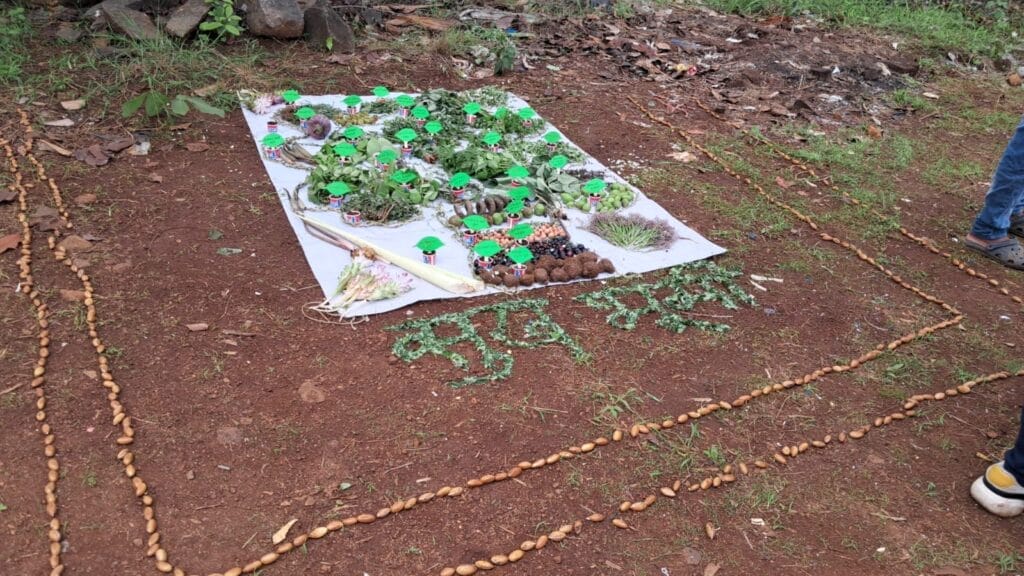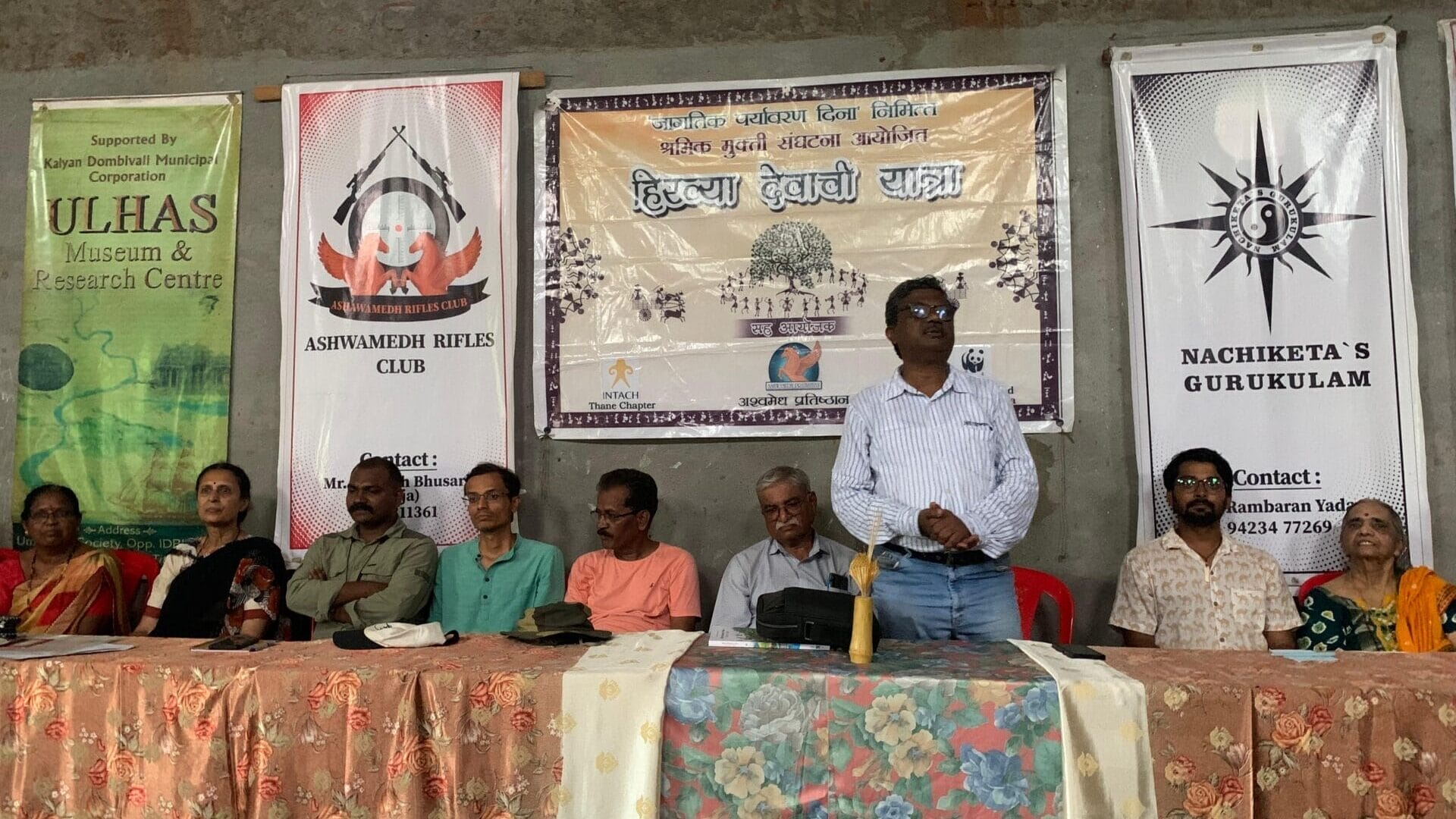Throughout the year, vegetable shops and markets are stocked with select vegetables and produce that form our diets. This produce is grown in large scale farms and sold across the country despite geographic and seasonal variations. But 23rd June was an aberration for some of us, who spent time at the Hirvya Devachi Yatra. We got in touch with forest foods that grow in the wild, people who harvest them and make delicacies out of these.
The Hirvya Devachi Yatra was organised this year by the Shramik Mukti Sanghatana, Van Niketan, Ashwamedh Pratisthan and INTACH Thane Chapter. It has been held every year for the past 10 years at Murbad, an outlying taluka in Thane district.
Tribal communities who live in villages near forest areas harvest a variety of wild forest foods as monsoon begins. However, their younger generations are getting disconnected from the use of wild vegetables, which naturally grow in the forest (uncultivated). The elderly women in the community are the last generation to use these vegetables.
Hirvya Dev means ‘Green God,’ and the festival celebrates and reinforces the idea of living in the forest and making use of what grows naturally with minimal human intervention.
Read more: New metro developments in Aarey Colony are threatening Adivasis
More than 100 people from urban areas of Mumbai, Nashik, Panvel, Kalyan as well as thakri and katkari women and children from the villages around Murbad participated in the gathering. We discussed the relationship that locals have with the forest.
We observed that calling a mix of groups – people from the villages and those who live in Mumbai had a dual effect. The villagers felt proud about their culture and saw city residents take an interest in their food, their culture, and their ways. And us urban residents got to learn about alternatives to mainstream recipes, vegetables, utensils and more. We were encouraged to look beyond our existing diets, and mainstream produce that is constantly available.
Landscape and political economy of Murbad
Murbad Taluka, lies in Thane district, off the road from Kalyan station. The village is primarily forested area, that falls within the Tansa and Bhimashankar wildlife corridor, that is spread over 320 sq. km. in Thane and Palghar districts of Maharashtra.
Murbad also happens to be an industrial zone, and a number of schools and colleges have also started in the past few years.
Many Adivasi (tribal) communities live in this forest, and are either engaged in agricultural work or factory related manual labour. Younger generations aspire to study and work in industries, and move away from agriculture, and later get jobs in these factories.
Given this trend, most of the farmers in Murbad are from older generations.
Unique wild vegetables
Most cultivated vegetables that we eat are grown in protected environments, with the use of pesticides and fertilisers. These wild greens however, grow by themselves; they are resilient as they do not require such chemicals.

Some of them include – loth bhaji, shevli, kakad, kartule or spine gourd, takla and more. The rest of the vegetation in Murbad is grown in family owned farms. Usually crops that are in demand in the market such as rice, wheat, and more are grown. These are sold at nearby marketplace at Kalyan.
Celebrating Hirva Dev, the Green God
As mentioned before, the event is a means of honouring the ways of living of the tribal communities everywhere. The organisers along with the villagers, cooked and served hot and delicious food, with breakfast, lunch and tea – including limited tasting of recipes using wild greens harvested this season from the forest.
There was also a display of dozens of wild vegetables harvested by women from groups from four hamlets around Murbad.
Anand Pendharkar, a biodiversity expert, conducted a forest walk while narrating numerous stories on the lives of the flora and fauna and our interdependence on the biota.
Read more: Delhi double standards: Celebrate urban farming, destroy traditional farmers
Several panellists from varied backgrounds shared their experiences of working with and in the forest department, as rescue specialists, sustainability practitioners, conservationists, activists, environment educators and so on.
Finally, there was a sharing circle among outstation participants facilitated by retired police officer Raju Patil, enabling time and opportunity for interaction between participants, in an offline and informal way.

While some of the participants were interested in ecology and learning about vegetation, for some others it was a first time experience to learn about these vegetables. For many, there was a sense of novelty towards these vegetables. There was a sense of surprise that some of these vegetables exist and are used in the place of mainstream greens such as spinach and bottle gourds.
Occasionally some of these greens do enter into markets, as seasonal vegetables. However, unless one is on the lookout to buy forest vegetables, they are not readily bought. In addition, the recipes for these vegetables are not well known.
In addition some of these greens are known to be irritants to the throat, so they need to be cooked in a particular way to neutralise this effect before consuming.
Festivals for wild vegetables and organic produce
Within Mumbai, similar programs are held in Aarey forest. Many Adivasi communities showcase their food habits and use of naturally growing vegetables. Palghar district’s Wada Taluka holds a similar function, run by Sukh Bhumi India Trust.
In Karjat taluka in Raigad district, wild vegetables grow in high numbers in the forested areas. These are used by the villagers and also brought into the nearby local markets in Neral and Karjat. Vanvadi, a forest collective in Karjat offers forest food walks each monsoon to create awareness about the wild edibles.
There is also growing popularity of farmers markets in Bandra, Juhu, Powai, where farmers themselves bring their produce to sell directly to the consumers. However, farmers markets are mostly initiated on the individual consumer, farmer or NGO level, with little state support.
Read more: No jobs, farming season over: How long before migrants returning to Patna set out again?
The government merely promotes farmer producer organisations to a certain extent, by giving them the space to sell. However, organic farming is already a costly process, and finding interested consumers is another challenge altogether. Farmers markets provide that bridge.
Bring back local, seasonal, natural…
In the last 30 years, there has been a rising trend of ‘universalisation’ of greens and crops. Earlier seasonal, regional and local conditions were extremely important in determining what was cultivated and consumed. But now, transport and markets dictate what is grown and what we eat.
For example, there has been a shift from eating millets such as Jowari, Bajri, Naachni to wheat and rice. This shift could be pushing us away from our own nutrition requirements over time. Getting to know what our parents’ generation ate, will help us resist such universalisation.
Ultimately we must talk about food, and the shifts in the history of food, grains, and vegetables to understand how we can eat better and grow crops without heavy environmental degradation.
Thorough and to the point coverage of the event. Very nice article.